You searched for: ��������������������������������������������� ���fuk7778���labor
<< Previous | Displaying results 451-500 of 1002 for "��������������������������������������������� ���fuk7778���labor" | Next >>
-
Gertruda Nowak: Maps
Media EssayGertruda Nowak was born to a Roman Catholic family in Poland. The Germans invaded her country on September 1, 1939. Gertruda's father was later accused of working for the Polish underground and taken away. The Germans then came for the rest of the...
-
Guta Blass Weintraub: Maps
Media EssayGuta Blass Weintraub was born to Jewish parents in Lodz, Poland. Not long after Guta entered secondary school, the Germans invaded Poland. Guta was forced to work in labor camps until 1944, when she was deported to the Majowka camp. From there, sh...
-
Moses Rechnitz: Maps
Media EssayMoses Rechnitz was born to Jewish parents in the Polish town of Bedzin on June 3, 1923. Moses was 16 years old when German troops invaded Poland in September 1939. By 1941, he was a slave laborer on a German railroad construction project outside o...
-
Ravensbrück - Maps
Media EssayThe Ravensbrück concentration camp was the largest concentration camp for women in the German Reich.
-
Neuengamme - Maps
Media EssayThe SS first established Neuengamme in December 1938 as a subcamp of Sachsenhausen. Later, in June 1940, the SS decided to establish an independent concentration camp at Neuengamme. Prisoners of the camp were subjected to horrific living condition...
-
Dachau - Historical Film Footage
Media EssayDachau opened in Germany in March 1933. It was the first regular concentration camp of the Nazi regime. Prisoners were subjected to horrific conditions, forced labor, and medical experiments. Dachau became the model for all other Nazi concentratio...
-
Receiving tattoos at Auschwitz
Media EssayThe Auschwitz camp complex was the only location that issued identifying tattoos during the Holocaust. Only prisoners selected for forced labor were assigned serial numbers. Prisoners who were sent directly to the gas chambers were not registered or...
-
Auschwitz - ID Card/Oral History
Media EssayThe Auschwiz camp complex was the largest of its kind established by the Nazi regime. Auschwitz consisted of three main camps, including a killing center. More than 1.1 million people were murdered at Auschwitz. Individuals not sent directly to th...
-
Auschwitz (Abridged Article) - Photographs
Media EssayThe Auschwiz camp complex was the largest of its kind established by the Nazi regime. Auschwitz consisted of three main camps, including a killing center. Individuals not sent directly to the gas chambers were sente...
-
Auschwitz (Abridged Article) - Animated Map/Map
Media EssayThe Auschwitz concentration camp complex was the largest of its kind established by the Nazi regime. It included three main camps. All three camps used prisoners for forced labor. One of them also functioned for an extended period as a killing cente...
-
Auschwitz (Abridged Article) - ID Card/Oral History
Media EssayThe Auschwiz camp complex was the largest of its kind established by the Nazi regime. Auschwitz consisted of three main camps, including a killing center. Individuals not sent directly to the gas chambers were sentenced to forced labor. More...
-
Treblinka: Maps
Media EssayThe Treblinka killing center was one of four camps linked to Operation Reinhard. Known as Treblinka II, it opened in July 1942 about a mile from from Treblinka I, the labor camp. The Germans killed an estimated 925,000 Jews at Treblinka II, as well...

-
Camp System: Maps
Media EssayBetween 1933 and 1945, Nazi Germany and its allies established more than 42,000 camps and othe...
-
Roma (Gypsies) in Romania
FilmAbout a million Roma (Gypsies) lived in Europe before World War II. The largest Romani community—of about 300,000—was in Romania. This film shows a Romani (Gypsy) community in Moreni, a small town northwest of Bucharest. Many Roma led a nomadic lifestyle and often worked as small traders, craftsmen, merchants, laborers, and muscians.

-
Frieda Greinegger and Julian Noga
PhotoA hand-tinted photograph of Frieda Greinegger and Julian Noga as a young couple. The two had met when Julian, a forced laborer from Poland, arrived at the Greinegger farm in northern Austria. In 1941, the Gestapo sent both to concentration camps after learning of their forbidden friendship. Place uncertain, after 1945.
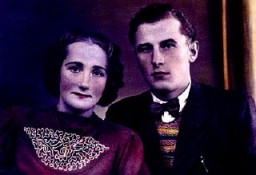
-
A portrait of the Greinegger family
PhotoThe Greinegger family, shown here in a formal portrait, were prosperous farmers in northern Austria. During World War II, the son died as a soldier in the German army. The second youngest daughter, Frieda, spent almost two years in Ravensbrück concentration camp for consorting with a Polish forced laborer, Julian Noga. Frieda and Julian married after the war. Place and date of photograph uncertain.
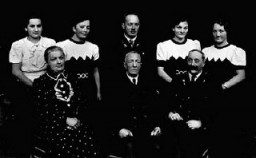
-
Portrait of Yosef Eschkenasi and his wife, Sara
PhotoPortrait of Yosef Eschkenasi and his wife, Sara. Yosef was a laborer. They lived at Zmayeva 10 in Bitola. This photograph was one of the individual and family portraits of members of the Jewish community of Bitola, Macedonia, used by Bulgarian occupation authorities to register the Jewish population prior to its deportation in March 1943.

-
Insignia of the 14th Armored Division
PhotoInsignia of the 14th Armored Division. Although lacking a nickname during the war, the 14th became known as the "Liberators" soon afterward to signify its accomplishments in liberating hundreds of thousands of forced and slave laborers, concentration camp prisoners, and Allied prisoners of war in 1945.
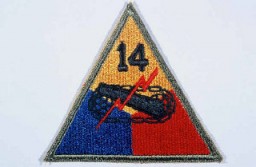
-
Liberator Vernon Tott
PhotoLiberator Vernon Tott (second from left) of the 84th Infantry was honored by some of the survivors he helped free from the Ahlem labor camp near Hanover, Germany. Tott's name was engraved on the Museum's Donor's Lounge wall with the inscription: "In honor of Vernon W. Tott, my liberator & hero." The ceremony in which Tott's name was unveiled came as a complete surprise to him. Washington, DC, November 2003.
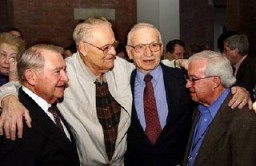
-
Persecution of Roma (Gypsies), 1939-1945
MapRoma (Gypsies) were among the groups singled out on racial grounds for persecution by the Nazi regime. Roma were subjected to internment, deportation, and forced labor, and were sent to killing centers. Einsatzgruppen also killed tens of thousands of Roma in the German-occupied eastern territories. The fate of the Roma closely paralleled that of Jews.

-
Jack Kakis
PhotoPostwar photograph of partisan Jack Kakis in Arta, Greece, 1950. After the German occupation of Greece, Jack escaped from a labor camp. He returned to Athens where he became involved with the underground movement, bombing factories, and writing anti-German slogans on the city streets at night. Eventually he joined the National Liberation Front, or EAM, and took to the mountains.
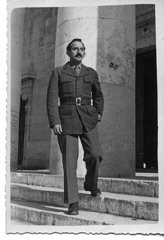
-
The White Rose Opposition Movement
ArticleThe White Rose, led by students including Hans and Sophie Scholl, was an anti-Nazi group during WWII. Its members spread leaflets denouncing the regime.
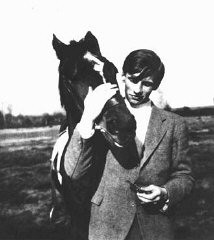
-
Miriam Goldberg
ArticleChildren's diaries bear witness to some of the most heartbreaking experiences of the Holocaust. Learn about the diary and experiences of Miriam Goldberg.
-
Israel Unikowski
ArticleChildren's diaries bear witness to some of the most heartbreaking events of the Holocaust. Learn about the diary and experiences of Israel Unikowski.
-
The Netherlands
ArticleLearn more about the Netherlands during the Holocaust and the fate of Dutch Jews after the 1940 German invasion.
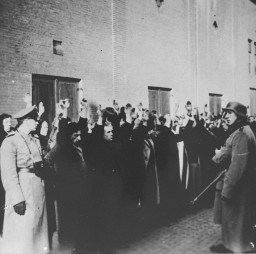
-
Latvia
ArticleBetween 1940 and 1944, Latvia was occupied by the Soviets and then by the Germans. These occupations had grave consequences for Jews in Latvia. Learn more.
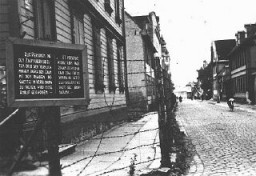
-
Jewish Uprisings in Camps
ArticleLearn more about Jewish prisoners and the various uprisings and armed resistance movements in killing centers and other Nazi camps.

-
Subsequent Nuremberg Proceedings, Case #2: The Milch Case
ArticleThe Milch Case was Case #2 of 12 Subsequent Nuremberg Proceedings against leading German industrialists, military figures, SS perpetrators, and others.

-
Deadly Medicine: Irmgard Huber
ArticleIrmgard Huber was head nurse of the facility at Hadamar, one of 6 major "euthanasia" killing centers in Nazi Germany. Learn more about her role.

-
Sholem Asch
ArticleSholem Asch was a Yiddish dramatist and novelist. He depicted small town Jewish life and socialist themes. His work was burned in Nazi Germany in 1933.

-
Alfred Rosenberg
ArticleNazi ideologue Alfred Rosenberg was found guilty at the postwar trial of leading Nazi officials, and was sentenced to death. Learn more about his roles.

-
Administration of the Auschwitz Camp Complex
ArticleLearn about the administration and commandants of the Auschwitz camp complex in German-occupied Poland.
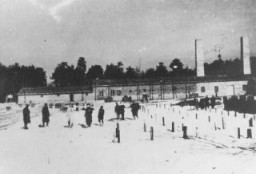
-
Cookbooks and Recipes
ArticleEach cookbook or recipe in the Museum’s collection tells a story. Learn more about the significance of these documents during the Holocaust.
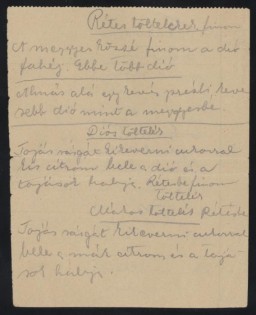
-
Morris Hillquit
ArticleMorris Hillquit was a prominent theoretician of the socialist movement in the United States. His work was burned in the Nazi book burnings of 1933. Learn more.
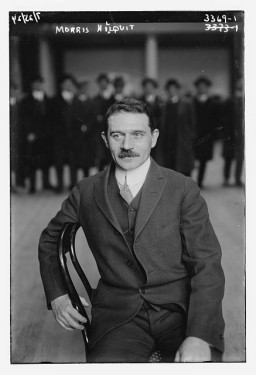
-
Ferdinand Lassalle
ArticleFerdinand Lassalle was a founder of the German labor movement. Some 70 years after his death, his works were burned in Nazi Germany for their socialist doctrine.
-
John Reed
ArticleJohn Reed was a journalist who helped found the Communist US Labor Party. During the 1933 Nazi book burnings, his work was burned for its Communist sympathies.
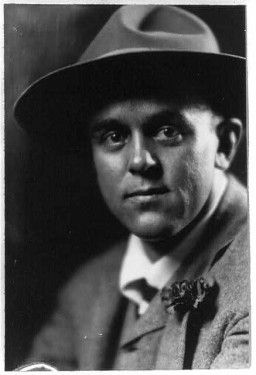
-
Stuttgart West Displaced Persons Camp
ArticleAfter WWII, many Holocaust survivors, unable to return to their homes, lived in displaced persons camps in Germany, Austria, and Italy. Read about Stuttgart West Displaced DP camp.

-
Upton Sinclair
ArticleUpton Sinclair was an American author whose works exposed social injustice and economic exploitation. His works were burned in Nazi Germany in 1933. Learn more.
-
Walter Marx
ArticleRead the Jewish Partisan Educational Foundation's short biography of Walter Marx.
-
German Order Policemen stand guard over a group of Jewish men
PhotoMembers of the German Order Police stand guard over a group of Orthodox Jewish men, 1942. The men have been rounded-up either for forced labor or public humiliation. Krakow, in German-occupied Poland.

-
The 29th Infantry Division during World War II
ArticleThe 29th Infantry Division participated in major WWII campaigns and is recognized for liberating Dinslaken, a civilian labor camp, in 1945.
-
Yitzhak (Irving) Balsam: Maps
Media EssayYitzhak Balsam was just under 15 years old when Germany invaded Poland in September 1939. Like other Jewish men in Praszka, he was forced to build roads outside of town. Yitzhak was later deported to several camps, including Auschwitz, and was imp...
-
Meyer (Max) Rodriguez Garcia: Maps
Media EssayMeyer (Max) Rodriguez Garcia was born to a Jewish family in Amsterdam. Max was nearly 16 years old when Germany invaded the Netherlands in May 1940. He went into hiding in early 1943, but was caught by June and deported to Auschwitz in German-occu...
-
Pages from Stanislava Roztropowicz's Diary
Media EssayDiaries reveal some of the most intimate, heart-wrenching accounts of the Holocaust. They record in real time the feelings of loss, fear, and, sometimes, hope of those facing extraordinary peril. Stanislava Roztropowicz kept a diary from 1943-1944...

-
Diagram of the “Gypsy camp” in Hodonín u Kunštátu
DocumentDiagram of the Hodonín u Kunštátu (Hodonin bei Kunstadt) camp in the Protectorate of Bohemia and Moravia (Czech Republic). Before it was converted into a Zigeunerlager (“Gypsy camp”) in 1942, it served as a penal labor camp. Translation of key: Scale 1:500 Sleeping quarters Sleeping quarters Mess-hall Infirmary Offices, prison Living quarters for guard staff Economic/Agricultural Building Latrine Well Mess-hall for guard staff Pens for guard dogs
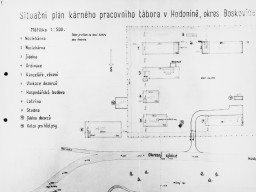
-
Mass grave for individuals murdered by the NKVD in Lvov prisons
PhotoA mass grave dug by Jewish forced laborers for the bodies of individuals murdered by the NKVD in Lvov prisons. The NKVD (Soviet secret police) murdered thousands of Ukrainian nationalists, as well as some Jews and Poles, before retreating from the Nazi invasion. The Germans and their Ukrainian collaborators then used the massacre as a pretext for anti-Jewish pogroms, claiming that the Jews had helped the secret police. Lvov, Poland, July 3, 1941.
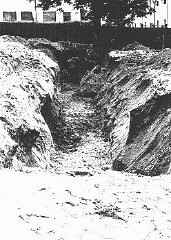
-
Père Jacques de Jésus (born Lucien Bunel)
PhotoPère Jacques de Jésus (born Lucien Bunel) was a Carmelite headmaster of a Catholic boys school in Avon, France. Angered at Nazi policies, he made his school a refuge for young men seeking to avoid forced labor and for Jews. On January 15, 1944, the Gestapo raided the school, seizing Père Jacques and three Jewish children. The boys were deported to Auschwitz and killed. Père Jacques, sent to various concentration camps, died shortly after liberation.
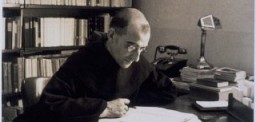
-
Prisoners arriving at the Belzec killing center
PhotoA column of prisoners arrives at the Belzec killing center. Belzec, Poland, ca. 1942. In early 1940 the Germans set up a forced-labor camp for Jewish prisoners in Belzec. The inmates were forced to build fortifications and dig anti-tank ditches along the demarcation line between Germany and Soviet-occupied Poland. The camp was closed down at the end of 1940. The following year, in November 1941, construction began on the Belzec killing center.
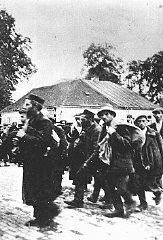
-
Natzweiler-Struthof
ArticleThe Nazis opened the Natzweiler-Struthof concentration camp in 1941. Learn more about the camp, its prisoners, and forced labor and medical experiments.
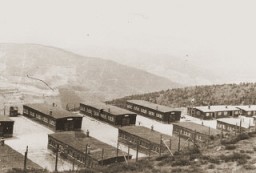
-
Chaim Benzion Cale
ArticleChildren's diaries bear witness to some of the most heartbreaking events of the Holocaust. Learn about the diary and experiences of Chaim Benzion Cale.

